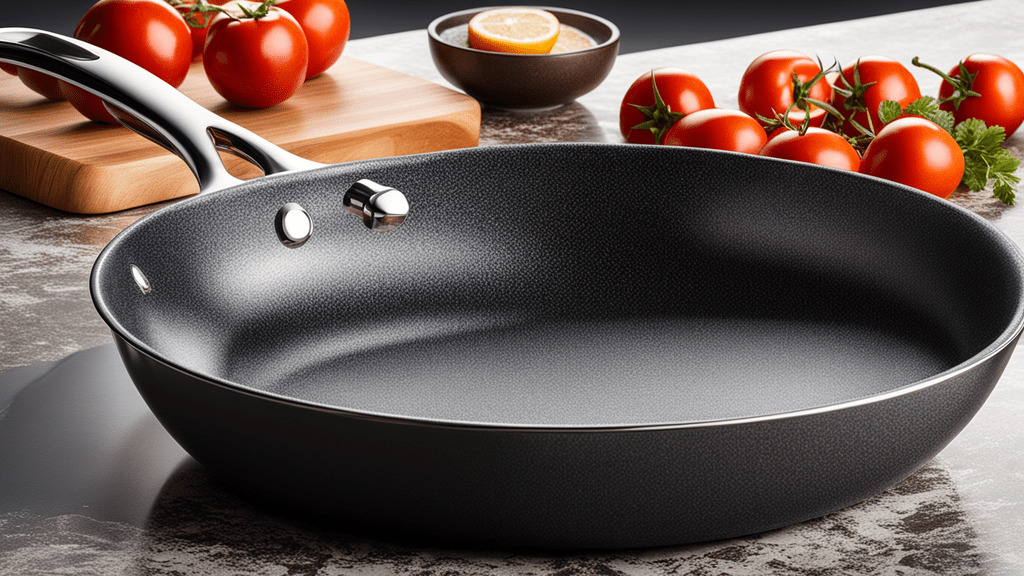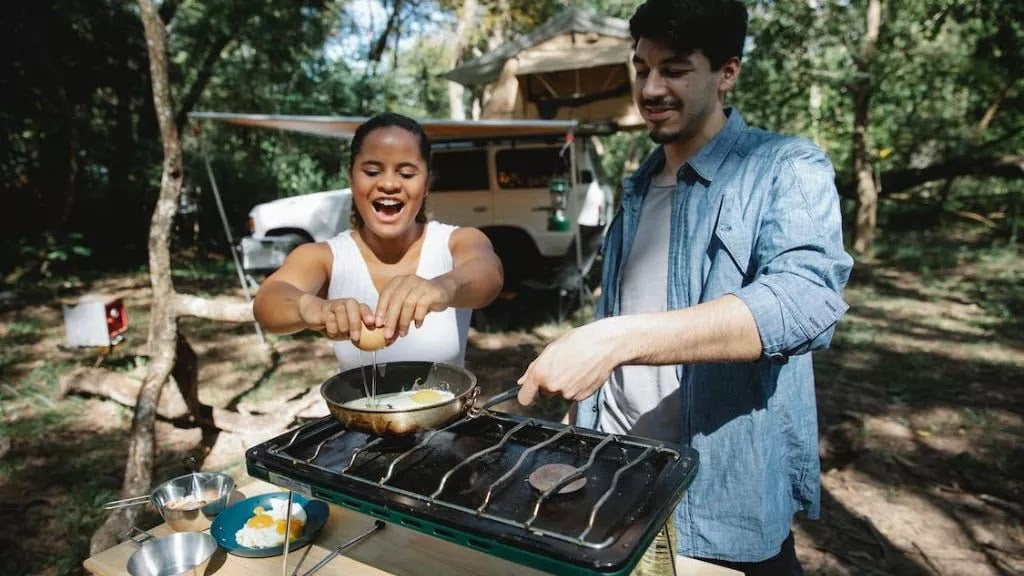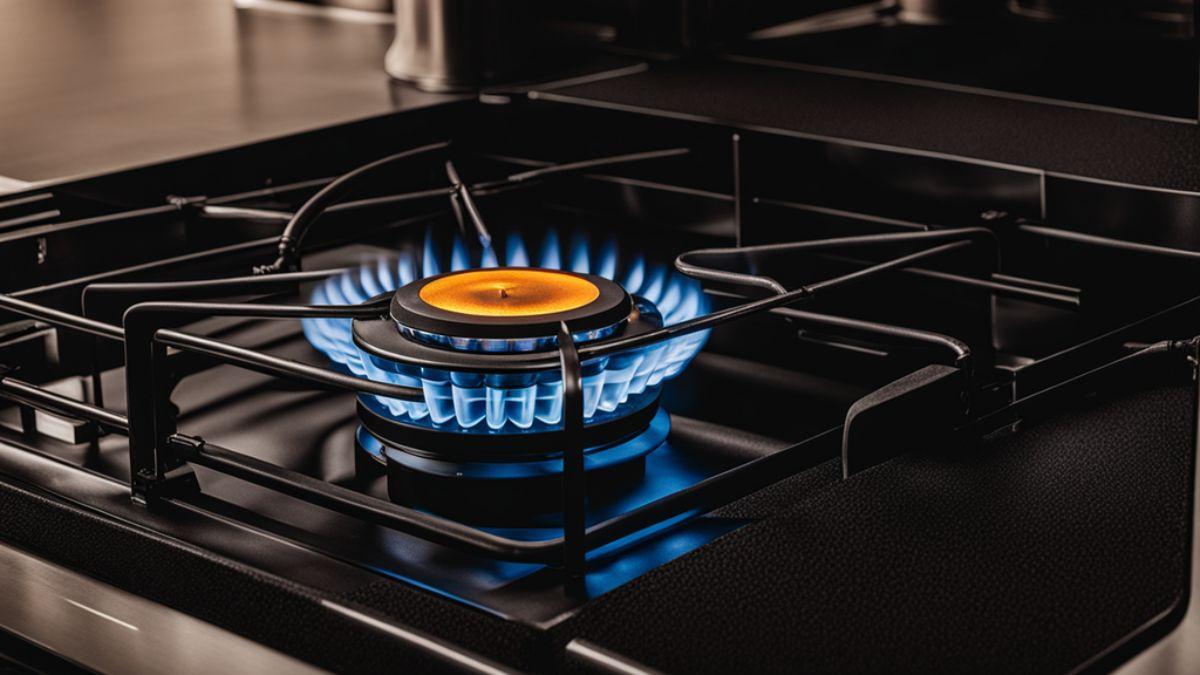
We may earn money or products from the companies mentioned in this post.
Granite frying pans are durable and non-stick but can be heavy and may require seasoning. They offer even heat distribution, yet their surface may degrade with dishwasher use.
Granite frying pans have carved a niche in modern kitchens due to their robust construction and natural non-stick properties. These pans, forged from a mixture of stainless steel and a granite-like coating, are known for withstanding high temperatures and resisting scratches.
Cooks often praise them for their aesthetic appeal, bringing a touch of elegance to the cooktop. Their ability to cook food evenly without the need for excessive oil makes them a favorite among health-conscious consumers. Despite their numerous benefits, potential buyers should consider that granite frying pans might not be the lightest option in their cookware arsenal and they often require careful maintenance to preserve their non-stick qualities. As kitchen enthusiasts weigh their cookware options, granite frying pans present a blend of tradition and modernity, making them an interesting choice for both seasoned chefs and culinary novices alike.
Read More: Can Induction Base Cookware Be Used on Gas Stoves? Myth-Busting Facts!

Credit: www.reddit.com
Introduction To Granite Frying Pans
Granite frying pans have sparked a revolution in modern kitchens. These durable, non-stick marvels provide excellent heat distribution, making them a go-to choice for chefs and home cooks alike. Let’s explore what puts granite pans on the map and whether they deserve a spot on your stovetop.
The Rise In Popularity Of Granite Cookware
Once an underdog in the world of cookware, granite frying pans have quickly become kitchen favorites. Their appealing look, combined with a reputation for toughness, has catapulted them to stardom. Users love the easy clean-up and consistent cooking results these pans offer.
Key Components And Construction
At the heart of a granite frying pan is carbon steel or aluminum for swift and even cooking. Wrapped in a non-stick coating that imitates the appearance of granite, the construction promises a scratch-resistant and durable surface. Here’s a quick look at what goes into these pans:
- Core material: Usually high-quality aluminum or steel
- Non-stick coating: A multi-layer, PFOA-free surface
- External layer: Mimics a speckled granite rock for a stylish finish
Read More: Can I Put My Crock Pot Insert on the Stove? Safe Use Tips
Benefits Of Using Granite Pans
Granite frying pans are popular in kitchens today. They bring a mix of style and functionality. Here are some benefits of using granite pans.
Non-stick Surface And Easy Cleanup
Enjoys the ease of cooking with the non-stick surface of granite pans. Food slides off easily. This means less need for oil or butter, which is great for health. Cleanup is a breeze – a quick wipe often does the job. You spend less time scrubbing and more time enjoying your meals.
Durability And Resistance To Wear
Granite frying pans stand the test of time. They resist scratches and chips better than other materials. They don’t react to acidic foods. So, they last longer, making them a reliable tool for any cook.
Even Heat Distribution For Better Cooking
These pans are known for spreading heat evenly. This avoids hot spots. Your food cooks more consistently. Achieve perfectly cooked dishes every time.
Aesthetics: Adding Elegance To Your Kitchen
Granite pans are not just practical, they’re also beautiful. They add an elegant touch to any kitchen. The sleek design goes well with any décor. Show them off on your stove or pot rack.
Read More: Granite Cookware Benefits: 5 Reasons to Make the Switch
Drawbacks Worth Considering
While granite frying pans offer remarkable non-stick features and durability, certain drawbacks demand attention before making a purchase.
Weight: Heavier Than Other Alternatives
Granite frying pans stand out for their heft, which can be a double-edged sword. The weight ensures steadiness on the stove but can become a challenge during handling, especially for those with wrist or arm mobility issues. Here’s a quick comparison:
| Material | Average Weight |
|---|---|
| Granite | Heavier |
| Aluminum | Lighter |
| Stainless Steel | Moderate |
Potential Safety Concerns Over Material
Some users express concerns over possible health risks with granite cookware. Despite these pans typically being safe, low-quality versions may contain harmful metals or chemicals. This necessitates a careful selection from reputable brands.
Heat Limitations And Cooking Adjustments
Granite frying pans require specific heat settings to avoid damage. Unlike metal pans, they can’t withstand very high temperatures; thus, cooking on medium heat becomes essential. Overheating could cause food to stick or the pan to lose its non-stick properties.
Longevity Compared To Other Materials
While granite pans are tough, they may not outlive other types. With time, the non-stick surface can wear down, which can be faster than in pans made of materials like cast iron or high-quality stainless steel. It’s essential to consider this trade-off when choosing the right cookware for long-term use.
Read More: How Hot Can an Electric Stove Burner Coil Get: Sizzling Facts!
Maintenance And Care For Longevity
Granite frying pans offer a unique combination of durability and non-stick convenience, promising a seamless cooking experience. Like any kitchen tool, their lifespan greatly depends on proper maintenance and care. To ensure your granite frying pan serves you well for years to come, adhering to specific maintenance protocols is essential.
Best Practices For Cleaning And Storage
Proper cleaning and storage are crucial for maintaining the integrity of your granite frying pan. After each use, wait for the pan to cool down before proceeding. Clean the pan with warm soapy water and a soft sponge to prevent scratches. Dry it thoroughly to avoid water spots or potential rust on any metal parts.
Always store the pan in a dry place. Stack pans with care to prevent scratches. Using pan protectors or soft cloths between them can help preserve the non-stick surface. Hanging the pans is also a great option to avoid unnecessary contact.
Avoiding Common Damages
- Use the right utensils: Opt for wooden or silicone tools rather than metal to prevent scratching the surface.
- Mind the heat: Excessive heat can damage the non-stick coating. Always cook on medium heat or lower.
- Steer clear of abrasive cleaners: Harsh chemicals or scrubbing pads can erode the non-stick layer. Stick to gentle cleaners.
Seasoning Your Pan: Is It Necessary?
Traditional granite frying pans do not require seasoning like cast iron cookware. However, a light coat of oil after cleaning can maintain the non-stick surface. Apply a teaspoon of oil, wipe it around with a paper towel, and heat the pan briefly before storing.
Remember, seasoning is not a substitute for proper cleaning. Only use this method if the manufacturer recommends it.
Read More: Bklyn Steel Co Ceramic Nonstick Cookware Set: Sizzle in Style!
Granite Pans Versus Other Cookware
When it comes to choosing cookware, a myriad of options flood the market. Shiny stainless steel, durable cast iron, and various coated pans vie for attention. Amongst these, granite frying pans stand out. These pans offer an interesting blend of durability and non-stick convenience. Still, before choosing granite, weighing the pros and cons against other popular cookware materials matters.
Comparing Granite To Cast Iron And Stainless Steel
Cast iron cookware sets the bar high for heat retention and durability. Granite pans, by contrast, heat up quickly but don’t hold temperature as well. Unlike cast iron, granite doesn’t require seasoning and is easier to handle due to its lighter weight.
As for stainless steel, its prowess lies in versatility and strength. Granite-coated pans offer some of the stainless steel’s robustness but with a natural non-stick surface. This makes granite pans easier to clean.
When To Choose Granite Over Non-stick Coatings
Non-stick cookware provides exceptional convenience but often comes with concerns over health and longevity. Granite pans step in as a great alternative. They boast a non-stick surface without the chemicals typically found in traditional non-stick coatings. If you prioritize safety and easy cleanup, granite is the prudent choice.
Price And Accessibility
Granite cookware strikes a balance between affordability and quality. While it may not be as cheap as some non-stick options, it often offers better value over time. Granite pans are readily available both in stores and online, making them an accessible choice for chefs at every level.

Credit: www.infarrantlycreative.net
Making The Right Choice For Your Kitchen
Granite frying pans have carved a niche in modern kitchens. These cookware items blend aesthetic appeal with functional prowess. But how do you decide if they’re the right fit for your culinary needs? Let’s explore their various facets to help you make an informed choice.
Considering Your Cooking Habits
Your daily cooking habits play a pivotal role in choosing the right cookware. Granite frying pans suit those who prefer:
- Non-toxic cooking surfaces: Granite is free from PFOA and PTFE.
- Even heat distribution: It ensures your food cooks uniformly.
- Using less oil for a healthier lifestyle.
If you rarely cook or prefer high-heat methods, other options might suit you better.
Balancing Pros And Cons With Personal Preference
Pros
- Granite pans offer durability and resistance to scratches.
- Easy to clean, typically needing just a wipe.
- They are beautiful and enhance kitchen decor.
Cons
- They can be heavier than other pans.
- Not suitable for high-heat cooking methods.
- May require careful handling to maintain the coating.
Match these features with your cooking style and what you value most in cookware.
Recommendations For Different Types Of Cooks
Here’s a guide to see if granite frying pans align with your cooking approach:
| Type of Cook | Should You Consider Granite? |
|---|---|
| Health-Conscious Cook | Yes, less oil is needed and a non-toxic surface. |
| Casual Cook | Yes, for the ease of maintenance and cleaning. |
| Professional Chef | Possibly, but not for high-heat dishes. |
| Adventurous Cook | Consider other options for high-temperature cooking. |
Whether you’re a beginner or a seasoned chef, weighing these suggestions can narrow down your choices.
Testimonials And Recipes
Exploring the world of cookware brings us to granite frying pans – a kitchen favorite for many. They promise non-stick convenience and durability. Here, users share their real-life experiences, and we’ll sprinkle in some delicious recipes that shine with this cookery.
User Experiences And Reviews
Users rave about the non-stick surface. This feature tops the charts in granite frying pan reviews. Home chefs find that everything from eggs to fish slides off easily, simplifying both cooking and cleaning.
- Handles remain cool, ensuring a safe grip every time.
- Even heat distribution is often highlighted, preventing those unwanted hotspots.
- Weight is manageable, not too heavy nor too light.
- However, some note that the surface can chip if not handled with care.
Julie M. says, “My pancakes never stick, and clean-up is a breeze.” John C. mentions, “Over time, I noticed some scratches, so make sure to use wooden utensils.”
Favorite Recipes To Try With Your Granite Pan
Granite frying pans excel with certain recipes. Consider recipes that benefit from a consistent, even heat.
- Perfect Pancakes: They brown beautifully without sticking.
- Crispy Skin Salmon: The pan’s heat retention gets the skin just right.
- Sautéed Vegetables: The pan’s surface ensures veggies won’t stick or burn.
| Recipe | Ingredients | Cooking Time |
|---|---|---|
| Perfect Pancakes | Flour, Eggs, Milk, Baking Powder | 10-15 mins |
| Crispy Skin Salmon | Salmon, Salt, Pepper, Oil | 8-10 mins |
| Sautéed Vegetables | Assorted Veggies, Salt, Pepper, Oil | 5-7 mins |
Explore these recipes on your next cook. They’re specially tailored to leverage your granite frying pan’s strengths!
Conclusion: To Granite Or Not?
Deciding whether a granite frying pan belongs in your kitchen is essential. Let’s revisit the key points.
Summing Up The Benefits And Setbacks
Granite frying pans charm with their durability and style. Non-stick surfaces make cooking and cleanup a breeze.
Even heat distribution ensures well-cooked meals. They are also safer with no harmful chemicals.
- Durable and scratch-resistant
- PTEE and PFOA free
- Easy to clean
- Even cooking
Still, they are not without downsides. Granite pans can be heavy. They might also require special care to maintain.
- Can be heavy
- May need careful handling
Final Tips Before Purchasing
Consider these points before buying a granite frying pan:
| Consideration | Detail |
|---|---|
| Weight | Ensure you can handle the pan comfortably. |
| Size | Choose a size that fits your cooking needs. |
| Compatibility | Check if it’s suitable for your stove type. |
| Care | Read about care instructions to prolong life. |
Reading reviews and warranty details can help make a wise choice.
Choose reputable brands for quality assurance.
:max_bytes(150000):strip_icc()/__opt__aboutcom__coeus__resources__content_migration__serious_eats__seriouseats.com__2018__12__20181116-copper-pot-making-vicky-wasik-18-ee43034ff3634c8e834f58387fd9c330.jpg)
Credit: www.seriouseats.com
Frequently Asked Questions On Granite Frying Pans Pros And Cons
Are Granite Frying Pans Durable?
Can Granite Frying Pans Handle High Heat?
Are Granite Frying Pans Safe For Health?
How Does Food Taste After Cooking In Granite Pans?
Conclusion
Wrapping up our exploration of granite frying pans, we see a balance of benefits and drawbacks. Their durability and health-conscious surfaces win points, while weight and potential cost considerations urge caution. As you weigh your options, remember these attributes to make a smart kitchen investment.
Choose wisely for culinary success!






